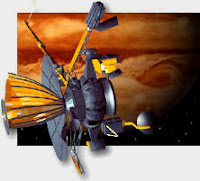Galileo plunged into Jupiter's crushing atmosphere on Sept. 21, 2003. The spacecraft was deliberately destroyed to protect one of its own discoveries - a possible ocean beneath the icy crust of the moon Europa.
Galileo changed the way we look at our solar system. The spacecraft was the first to fly past an asteroid and the first to discover a moon of an asteroid. It provided the only direct observations of a comet colliding with a planet.
Galileo was the first to measure Jupiter's atmosphere with a descent probe and the first to conduct long-term observations of the Jovian system from orbit. It found evidence of subsurface saltwater on Europa, Ganymede and Callisto and revealed the intensity of volcanic activity on Io.
Read on to learn more about the historic legacy of the Galileo mission.
Quick Facts
Launch: | 10.18.89 |  |
 |
 | End of Mission: | 9.21.03 |  |
 |
 | Jupiter Orbits: | 34 |  |
 |
 | Total Distance Traveled: | 4,631,778,000 km |  |
 |
 | Weight: | 2,223 kg |  |
 |
 | Height: | 5.3 meters |
|  |
 |  |  |
 |  |  |
|  |
Dimensions: 5.3 meters (17 feet) high; magnetometer boom extends 11 meters (36 feet) to one side |
Weight: 2,223 kilograms (2� tons, or 4,902 pounds), including 118 kilograms (260 pounds) of science instruments and 925 kilograms (2040 pounds) of propellant |
Power: 570 watts (at launch) from radioisotope thermoelectric generators |
Science Instruments: Solid-state imaging camera, near-infrared mapping spectrometer, ultraviolet spectrometer, photopolarimeter radiometer, magnetometer, energetic particles detector, plasma investigation, plasma wave subsystem, dust detector, heavy ion counter |
|
 |  |  |
|  |
Size: 127 centimeters (50 inches) diameter, 91 centimeters (36 inches) high |
Weight: 339 kilograms (750 pounds) |
Science Instruments: 339 kilograms (750 pounds) |
|
 |  |  |
|  |
Launch: Oct. 18, 1989 from Kennedy Space Center, Fla., on space shuttle Atlantis on mission STS-34 |
Primary Mission: October 1989 to December 1997 |
Extended Missions: Three, from 1997 to 2003 |
Venus Flyby: Feb. 10, 1990, at altitude of 16,000 km (10,000 mi) |
Earth Flybys: Dec. 8, 1990, at altitude of 960 km (597 mi); Dec. 8, 1992 at altitude of 303 km (188 mi) |
Asteroid Gaspra Flyby: Oct. 29, 1991, at 1,601 km (1,000 mi) |
Comet Shoemaker-Levy 9: Impacts of comet fragments into Jupiter observed while en route in July 1994 |
Asteroid Ida Flyby: Aug. 28, 1993, at 2,400 km (1,400 mi) |
Atmospheric Probe Release: July 12, 1995 |
Probe speed into Jupiter's atmosphere: 47.6 km per second (106,000 mi per hour) |
Jupiter arrival and orbit insertion: Dec. 7, 1995 |
Probe atmospheric entry and relay: Dec. 7, 1995 |
Number of Jupiter orbits during entire mission: 34 |
Number of flybys of Jupiter moons: Io 7, Callisto 8, Ganymede 8, Europa 11, Amalthea 1 |
Total distance traveled from launch to final impact: 4,631,778,000 kilometers (approx. 2.8 billion miles) |
Speed of spacecraft at time of impact: 48.2 kilometers per second (nearly 108,000 miles per hour) |
|
 |  |  |
|  |
Cost: Total from start of planning through end of mission is $1.39 billion. International contribution estimated at an additional $110 million |
Partners: More than 100 scientists from United States, Great Britain, Germany, France, Canada and Sweden carried out Galileo's experiments. NASA's Ames Research Center, Mountain View, Calif., responsible for atmosphere probe, built by Hughes Aircraft Company, El Segundo, Calif. Radioisotope thermoelectric generators designed and built by General Electric Co. for the U.S. Department of Energy |
Approximate number of people who worked on some portion of the Galileo mission: 800 |
|
|
DATA COLLECTED FROM
